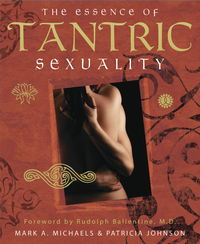Many consumers see their community bookstore as a source of wisdom on a wide variety of metaphysical topics. Talking to a real, breathing person—an experienced, friendly, and knowledgeable bookseller—about these matters gives added value to the traditional shopping experience.
Do customers come to you with questions about a particular subject? Maybe they only have a vague idea of what they are seeking and need to know more about a topic before taking the plunge.
With Valentine’s Day around the corner, you may notice more people interested in Tantra. We’ve invited Donald Michael Kraig to explain this ancient spiritual path and its relation to Tantric sex, so you’ll be prepared for any questions that come your way.
What is Tantra?
By Donald Michael Kraig
Sooner or later, any bookstore that focuses on spirituality is going to get questions about Tantra. Is it just weird sex stuff? Is it all in the Kama Sutra?
Because Tantra is thousands of years old, different versions have developed and each may have their own focus. In this article I’ll try to give an overview that can help you understand what Tantra is and why it’s a valuable spiritual path.
There is no universally accepted meaning of the word “Tantra.” A popular explanation is that it is a compound of two Sanskrit words, tan and tra, that translate as “warp” and “woof,” the directions of yarn in a loom. So Tantra could be seen to mean the loom of all reality.
This means Tantra covers everything—all the physical and spiritual sciences. What Tantra uniquely does is explore all of these things in a unified way from the point of view of the individual. “How does this apply to me?” is the question answered by Tantra.
The result is that the spiritual and the physical are united in Tantra. Virtually all of the spiritual and physical concepts that are thought to come from India—chakras, kundalini, karma, spiritual bodies, prana, etc.—originated in Tantra.
Yoga
The word yoga means “union,” implying a union with the Divine. (What most people call yoga—the moving of the body into different positions—is just one form of yoga.) Tantra Yoga is about the union of the individual with the Divine through understanding and working with the combined non-physical and physical worlds.
During the earliest period of our lives we have to learn to exist in the physical world, a necessity for survival that affects our bodies, minds and spirits. To learn Tantra you first unlearn almost everything and relearn a new way of thinking about ourselves and the world, a way free of artificial limitations we placed upon ourselves as we learned to survive.
This new way begins by understanding that everything is made of energy. This ancient Tantric concept is now a basis of modern science. Learning to understand and work with that energy results in learning about our physical and spiritual bodies, different forms of energy, the chakras, and how that energy interacts with the physical world.
Tantric Sexuality
One of the ways to work with this energy is through sexual activity. Certain sexual practices result in the movement of spiritual energy. But it takes more than just having sex to become enlightened! Tantric sexuality involves unlearning common sexual practices and learning new ones based on:
• A deep understanding of the physical body
• Intention
• Visualization and
• Spiritual awareness of the energy triggered by sex
There is an archetypal story of a couple immediately after sex. She wants to talk and cuddle while he rolls over and falls asleep. He’s expended energy and she’s absorbed it. With the techniques of Tantric sex anyone can learn to harness that energy and use it to achieve goals. Traditionally, the primary goal is to direct this energy through the non-physical body resulting in yoga—unity with the Divine—enlightenment.
These practices started to become popular in the West in the 1960s and 1970s. Some of the books on Tantric sex—more accurately called Neo-Tantra—are written by students of Baghwan Sri Rajneesh (AKA Osho).
Part of Tantric sex involves extended periods of ecstatic sexual activity. It’s possible to separate this from the more spiritual aspects of Tantra, and that has attracted the attention of many pleasure seekers.
War of the Tantrics?
You should be aware that some followers of Neo-Tantra don’t like those who focus on traditional Tantra. Likewise, some Traditional Tantrics don’t like the sexual focus of the Neo-Tantrics. Being aware of the interests of your customers can help you make recommendations that will fit their specific needs. Having the attitude that both Traditional and Neo-Tantra have value, and we can learn from both paths, may be the ideal approach.
***
Suggestions for a Valentine’s Day display:
The Essence of Tantric Sexuality
Mark A. Michaels, Patricia Johnson
Tantra for Erotic Empowerment :The Key to Enriching Your Sexual Life
Mark A. Michaels, Patricia Johnson
Sex and Transcendence: Enhance Your Relationships Through Meditations, Chakra & Energy Work

Keith Sherwood
Love and Intuition: A Psychic’s Guide to Creating Lasting Love
Sherrie Dillard
Sex Magic for Beginners: The Easy & Fun Way to Tap into the Law of Attraction
Skye Alexander
***
Donald Michael Kraig is the author of Modern Magick and Modern Sex Magick. He writes The Magical Universe blog and teaches courses in the Southern California area on such topics as Kabbalah, tarot, magic, tantra, and psychic development. He has been a member of many spiritual and magical groups and is an initiated Tantric.
Donald Michael Kraig on His Favorite Bookstore:
“I literally grew up at the Bodhi Tree in West Hollywood. They have in-depth sections on every metaphysical topic. Here’s hoping new owners will make it even greater!”
***
Do you have any special requests for a blog post? Want to hear from a specific author on a particular topic? Please let us know!





